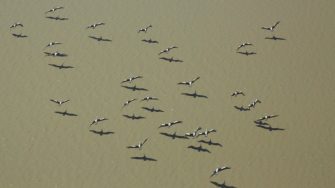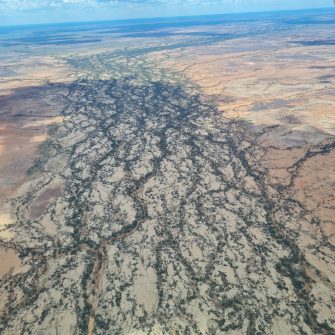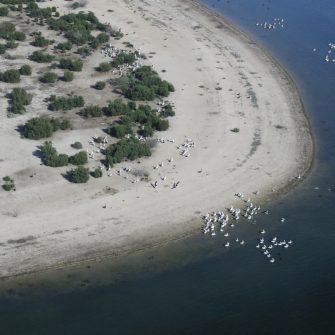
Background
Tracking long-term environmental change is critically important, particularly for freshwater ecosystems, often with high rates of decline.
Waterbirds are key indicators of freshwater ecosystem change, with groups reflecting food availability (e.g. piscivores and fish).
Species abundance, numbers of nests and broods and wetland area data are captured from aerial surveys of waterbirds across Australia, mostly at the species’ level (∼100 species) from three major aerial survey programs:
Eastern Australian Waterbird Survey: Across eastern Australia, we survey up to 2,000 wetlands annually (October, since 1983), along 10 survey bands (30 km wide), east to west across about one third of Australia (2,659,000 km2) (Fig.1).
National Survey: In 2008 we surveyed 4,858 wetlands across the entire Australian continent.
Murray-Darling Basin: Each year (since 2010) we survey the major wetlands in the Murray-Darling Basin.
Collectively these data inform regulation of environmental flows and wildlife management under the Murray-Darling Basin plan. The data also underpin regulation of hunting seasons in Victoria and South Australia, game bird culling in NSW, State of the Environment Reporting, environmental assessments, river and wetland management, the status of individual species and identification of high conservation sites.
Fig. 1 Wetlands surveyed (each dot) in the three waterbird aerial survey programs, across Australia, divided into the 12 major river basins (I-XII):
- Eastern Australian Waterbird Surveys (yellow circles, 10 survey bands, 30 km wide, 200 km separated, east to west);
- National waterbird survey (purple circles)
- Waterbird surveys of the major wetlands in the Murray-Darling Basin (IV) (blue circles).
Major river basins numbered I) Carpentaria Coast, II) Tanami-Timor Sea Coast, III) Lake Eyre Basin, IV) Murray-Darling Basin, V) North East Coast, VI) Pilbara-Gascoyne VII) South Australian Gulf, VIII) South East Coast, IX) South West Coast, X) South Western Plateau, XI) Tasmania, XII) North Western Plateau.
Objectives
- to comprehensively survey waterbird species across eastern Australia and the Murray-Darling Basin (2018-2022), the Great Barrier Reef (2021) and coastal wetlands in South Australia (2022);
- to use eastern Australia data to track long-term changes in waterbird diversity, abundance and breeding, relative to natural and anthropogenic impacts on rivers and wetlands;
- to provide key data for the management of threatened and migratory waterbird species;
- to provide data that underpins environmental flow management and species’ management;
- to identify important wetland areas for conservation of waterbirds and other aquatic biota for protected areas (including the Great Barrier Reef and coastal South Australia), Ramsar listing and Important Bird Areas;
- to inform the implementation of the Murray-Darling Basin Plan in relation to waterbirds;
- to track changes in ecological character of internationally Ramsar listed wetlands;
- to maintain freshwater ecosystem functions and services, critical to sustaining (human) communities living across the Basin and;
- to provide data on game species of waterbirds to South Australian and Victorian governments in relation to management of duck hunting open seasons.
Methods
All wetlands are surveyed during October and November each year from a high-winged aircraft (Cessna 206) with two observers, one each side of the plane, estimating numbers of waterbirds of each species onto digital audio recorders.
The aircraft is flown at a height of 30 – 46 m and a speed of 167 km hr-1 (90 knots), within 150 m of the shoreline, where waterbirds usually congregate (Kingsford and Porter 1994).
Either the whole wetland is circumnavigated or a proportion of the wetland (> 50 %) counted. Counts for each species are totalled for each observer to give either a total count for a wetland or a proportional count for the wetland.
Waterbird and wetland data is entered and stored in a modern relational SQL database with a web user interface and can be queried using temporal and/or spatial filters.
Results
Aerial survey programs have delivered demonstrable practical improvements in the management and protection of our natural environment.
These aerial surveys significantly contributed to real-time environmental flow management in the Murray-Darling Basin Plan (MDBP). Declines in waterbird numbers first detected during aerial surveys for the Macquarie Marshes triggered the first substantial investment by the NSW Government in environmental flows, including the first water license buy backs. This initiative was continued over the Murray-Darling Basin by the Australian Government.
Aerial survey results have continued to inform the MDBP, identified significant areas of water management concern (i.e. Menindee Lakes), identified the effects of climate change on waterbirds and the challenges for managing the MDBP including reporting on Ramsar-listed wetland sites (a key focus for the MDBP).
Aerial surveys directly contributed to purchase of new protected areas including Currawinya National Park (Qld), Paroo-Darling National Park (NSW) and Yanga National Park (NSW) and contributed to establishment of three new National Parks in NSW: Narrierra and Caryapundy Swamp National Park, Thurloo Downs National Park, incorporating the Bulloo Overflow and Brindingabba National Park.
Aerial survey data were also essential to designations for the first two listed here as wetlands of international importance, under the Ramsar Convention. In 2008, waterbirds over more than 4,858 wetlands, covering 3.8 million hectares were surveyed. These data were instrumental in identifying many Important Bird Areas in Australia.
Aerial survey findings resulted in 34 peer-reviewed articles, including one in the Nature group of journals (Scientific Data), describing the methodology and an accessible public database. Data can be found in over 49 published and unpublished reports,
Each year, a summary report of the results is provided to four state governments (NSW, QLD, SA, VIC) and the Australian Government, within two months of survey completion.
The aerial survey team developed a blog, providing real-time information, including photographs and video footage each day of surveys to the public (2023 Blog).
Aerial survey data are determining the abundance and distribution of hunted species of ducks in Victoria and South Australia, supporting evidence-based management of hunting limits.
The aerial survey data were also integral in the development of a unique consortium, including the Centre for Ecosystem Science (UNSW), focusing on restoration of Gayini wetlands, led by First Nations people, the Nari Nari Tribal Council (NNTC), who now own and manage substantial environmental flows. The NNTC recently signed an agreement for wetland restoration with the NSW Biodiversity Conservation Trust.
The data were also pivotal to the assessment of conservation importance of game reserves and other reserves in South Australia. In 2021, surveys of Great Barrier Reef wetlands were important for priority conservation actions and policies. The data were also reported in the Australian Government’s State of Environment Report.
For stakeholders and others interested in the information on this fact sheet, we have created a version for downloading and sharing.



